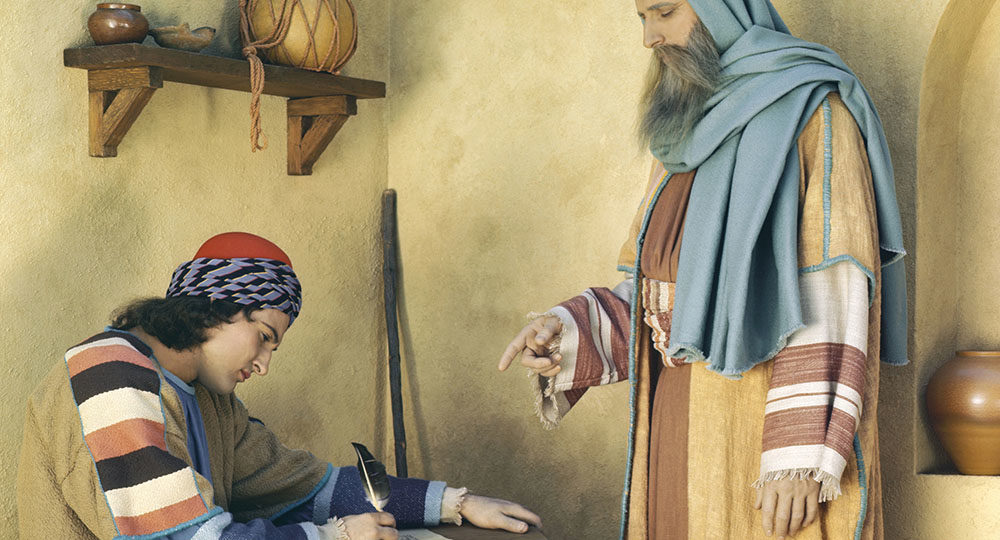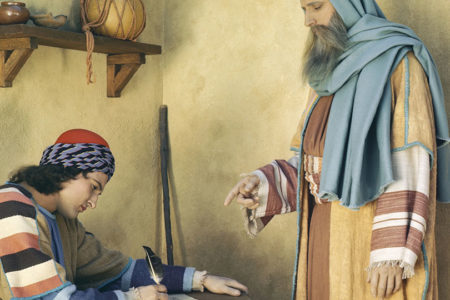Introduction to Jeremiah
The prophet Jeremiah ministered from 627 to about 585 B.C., more than 100 years after the trauma of Assyria’s destruction of the northern kingdom of Israel in 722 B.C. Yet the consequences of that tragedy were still apparent. The southern kingdom of Judah should have taken a lesson from Israel’s divine judgment. However, the Judeans apparently rationalized that the Temple’s presence in Judah protected them from Israel’s fate (Jer. 7:4).
They were wrong. God severely judged them for forsaking Him, sent the Judeans into captivity in Babylon, and allowed the Babylonians to destroy the Temple King Solomon had built. In fact, the theme of Jeremiah is “the judgment of Jehovah.”
The Political Situation
Judah had a scare in 701 B.C. when the Assyrians defeated every town in Judah except Jerusalem. God heard godly King Hezekiah’s plea for help and rescued Judah. Sadly, Hezekiah’s son Manasseh ushered in a colossal period of apostasy during his 55-year reign, even stooping to child sacrifice (2 Chr. 33:6). Tradition says the prophet Isaiah was martyred by Manasseh.
In an amazing display of grace, God drew Manasseh to Himself; and, at the end of Manasseh’s reign, the king repented of his wickedness. His godly son Josiah succeeded him in 640 B.C. and eventually sparked the last revival in Judah before the Babylonian Captivity. Jeremiah would have participated in the preaching that accompanied that revival.
Meanwhile, Assyria continued to dominate regional politics. Judah looked to Egypt for potential help and had to evaluate the role the rising Neo-Babylonian (Chaldean) Empire would play. In 612 B.C. Babylon conquered Nineveh, the Assyrian capital. The Assyrian army fled westward to Carchemish, where it regrouped.
In Egypt, Pharaoh Neco decided it would be advantageous to keep Assyria in existence as a buffer against Babylon. In 609 B.C. he therefore made his way north through Israel to join the Assyrian defenses far north of Israel at Carchemish, about 450 miles from Jerusalem.
Unfortunately, Josiah did not ask the Lord what to do. He tried to stop Neco and was killed in the Valley of Armageddon. Neco continued on to Carchemish where he and the Assyrians were eventually routed by the Babylonians in 605 B.C. General Nebuchadnezzar of the Neo-Babylonian army pursued the Egyptians southward and attacked Judah. Nebuchadnezzar’s father died about this time, and Nebuchadnezzar became king of Babylon.
This event started the three Jewish deportations that constitute the Babylonian Captivity. The prophet Daniel and several thousand upper-class citizens were taken to the capital city of Babylon in 605 B.C. In 597 B.C., the prophet Ezekiel and many common citizens were force-marched to the countryside of Babylonia, about 50 miles outside the capital. In 586 B.C. Jerusalem fell, the Temple was destroyed, and the majority of Judeans were deported.
The Babylonian Captivity was a bitter pill for the Jewish people, who longed for their homeland:
By the rivers of Babylon, there we sat down, yea, we wept when we remembered Zion. How shall we sing the Lᴏʀᴅ’s song in a foreign land? If I forget you, O Jerusalem, let my right hand forget its skill! (Ps. 137:1, 4–5).
Although God punished the Jewish people for their disobedience, He was also faithful to His promise to bring them back to their land after 70 years (Jer. 25:11–12).
Around the 70th anniversary of Daniel’s deportation, Zerubbabel brought almost 50,000 people back to Judah (Ezra 1—6). By the 70th anniversary of the Temple’s destruction, the second Temple was dedicated on the same site as the first (516 B.C.; see Haggai and Zechariah).
Jeremiah’s Background
Jeremiah is called the “weeping prophet” because of the tragic historical events surrounding his ministry and his emotional response to them. Of all the prophets, Jeremiah is the one on whom we have the most information concerning his deepest emotions, thoughts, attitudes, feelings, and interpersonal conflicts. Jeremiah is also considered the author of the book of Lamentations, which eloquently expresses the broken heart of this man of God, even when he was convinced God’s judgment was just and deserved.
Jeremiah’s name probably means “Jehovah has appointed.” This definition certainly fits with the details of his call to the ministry in Jeremiah 1:4–5: “Then the word of the Lᴏʀᴅ came to me, saying: ‘Before I formed you in the womb I knew you; before you were born I sanctified you; I ordained you a prophet to the nations.’”
The prophets Nahum, Zephaniah, Habakkuk, Daniel, and Ezekiel ministered during Jeremiah’s lifetime. Only Daniel referred to Jeremiah (Dan. 9), but Jeremiah did not refer to any of them. (The Zephaniah mentioned in Jeremiah was a priest of the tribe of Levi, not the prophet Zephaniah who was from the tribe of Judah.)
Elsewhere in Scripture, the books of Ezra and Matthew refer to Jeremiah’s writings. Second Kings and 2 Chronicles mention him in the history of the period.
Jeremiah was from the tribe of Levi (the priestly tribe). His hometown of Anathoth was also the home of Abiathar, the high priest deposed by Solomon in 1 Kings 2:26. Jeremiah never married as per God’s request (Jer. 16:1–2). When God called Jeremiah, He warned him of the trouble to come: brutality from the Gentile enemy (Babylon) and persecution from the Jewish leadership (vv. 3–4).
From 627 to 609 B.C. Jeremiah might have enjoyed some popularity under godly King Josiah. He participated in the revival of Temple worship and the public reading of the Law found when the Temple was being refurbished (2 Ki. 23:2).
Josiah’s premature and tragic death certainly rocked Jeremiah’s world. The kings who followed were neither godly nor sympathetic to Jeremiah’s ministry and resented him for condemning pagan idol worship, criticizing violations of the Law, and exposing the deceit of false prophets. Wicked King Jehoiakim prohibited him from entering the Temple or the royal palace and then cut up his writings and fed them to a fire, causing Jeremiah’s poor secretary, Baruch, to rewrite all the prophecies.
Eventually, King Zedekiah arrested Jeremiah, calling him a traitor for predicting Jerusalem would fall to Babylon. When the Babylonians conquered the city, they freed Jeremiah out of appreciation for his predictions.
The prophet continued to minister in Jerusalem after the majority of Judeans were deported. In the end, fellow Jews kidnapped him and fled with him to Egypt. As far as we know, Jeremiah died in Egypt.
Interestingly, about 100 years later, a temple to Yahu (possibly meaning Jehovah) in southern Egypt (at Elephantine) was mentioned in the correspondence of the Persian Empire. Jeremiah would not have encouraged the construction of such a temple, but its existence underscores the fact that a significant Jewish population existed in Egypt after the Babylonians captured Judah.
The history of this period is verified by the Babylonian Chronicles; the Lachish Letters; a seal belonging to Gedaliah; and a seal belonging to Jeremiah’s scribe, Baruch.1 The Babylonian Chronicles are tablets describing Babylon’s history from 2350 to 539 B.C.2 The Lachish Letters are written reports from a town about 30 miles from Jerusalem.3 The seal of Gedaliah is a signature device perhaps belonging to the man the Babylonians placed as governor of Judah, according to Jeremiah.4
The book of Jeremiah is a collection of the prophet’s sermons to the people of Judah. They are not in chronological order. Jeremiah 44 is actually Jeremiah’s final sermon. The theme, “the judgment of Jehovah,” comes from Judah’s refusal to forsake pagan worship and obey the sabbatical-year laws for 490 years.
Amazingly, there is one verse in Aramaic, the Gentile language of the region. It certainly is a theme verse for Gentile readers of Jeremiah. It warns, “But the Lᴏʀᴅ is the true God; He is the living God and the everlasting King. At His wrath the earth will tremble, and the nations will not be able to endure His indignation” (Jer. 10:10).
ENDNOTES
- J. G. S. S. Thomson, New Bible Dictionary, 3rd ed., ed. D. R. W. Wood and Howard I. Marshall (Downers Grove, IL: InterVarsity Press, 1996), Logos Electronic Version, 550.
- Carl Edwin Armerding, “Babylonian Chronicles,” The New International Dictionary of Biblical Archaeology, ed. Edward M. Blaiklock and R. K. Harrison (Grand Rapids, MI: Zondervan, 1983), 87.
- Gleason L. Archer, Jr., A Survey of Old Testament Introduction (Chicago, IL: Moody Press, 1974), 364.
- Several men named Gedaliah are mentioned in Jeremiah. See 38:1 and 40:5. They are differentiated by their fathers.








I have been trying to understand the intent of the Jews when they kidnapped Jeremiah and took him to Egypt. Did they think having a prophet with them would keep them in the graces of God? Or, did they keep him close to know what God was going to say next?